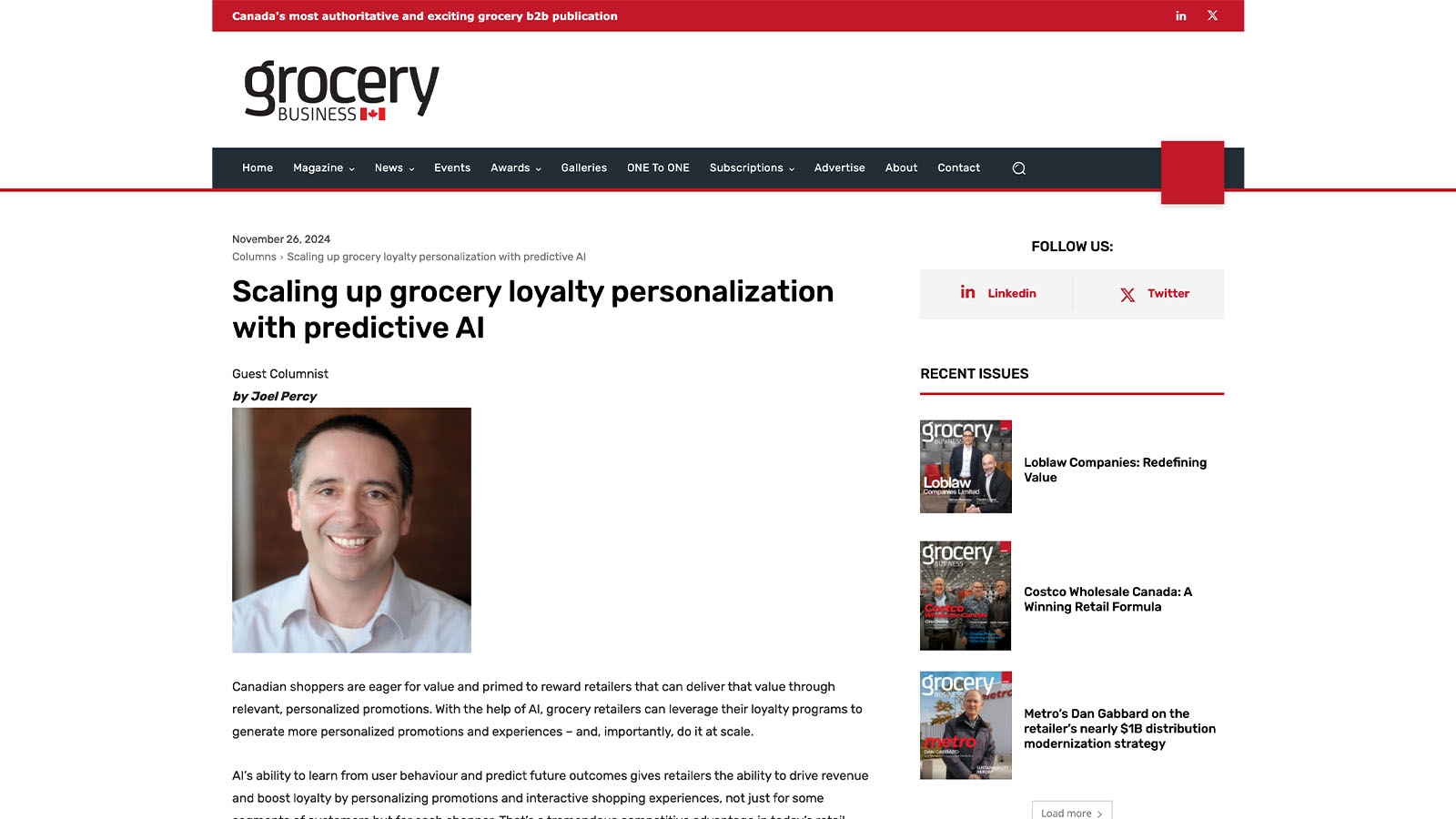3 min read
The Grocery Loyalty Landscape in Asia Pacific [A Survey Snapshot]
Consumer behaviours in APAC reveal opportunities for grocery retailers to drive more loyalty and customer retention by improving their rewards programmes.
Get the latest insights, research and news delivered straight to your inbox.
Plus, enter to win the 2nd edition of Omnichannel Retail by Tim Mason & Sarah Jarvis!
No spam. We promise. 💜
Featured Case Study:
See how Eagle Eye helped Giant Eagle relaunch myPerks, delivering 25M+ personalized offers monthly and boosting loyalty program ROI.
Contact us to find out how we can enable your teams on our platform.

4 min read
 Eagle Eye
on
12 June, 2023
Eagle Eye
on
12 June, 2023
![The Grocery Loyalty Landscape in Canada and the United States [A Survey Snapshot]](https://eagleeye.com/hubfs/images/featured/north-america-grocery-loyalty-snapshot.jpg)
Across Canada and the United States, the ongoing cost-of-living crisis continues to affect how consumers allocate their discretionary expenses and spending on necessities. Despite the higher cost of food at the grocery store, consumers are cooking more at home while ordering in and eating out less. This presents a unique opportunity for grocery retailers to engage these shoppers and gain their loyalty within the current economic climate and beyond.
While they may be dedicating a larger portion of their budget to grocery store purchases, North American shoppers are also actively seeking ways to save money on the shelf. These insights come from our recent global consumer survey, Grocery’s Great Loyalty Opportunity, which examines how consumers worldwide and within North America (Canada and the United States) feel about rewards programs, what drives their purchasing preferences, and what makes them loyal to retailers, including grocers.
We've summarised our findings in the North America Grocery Loyalty Snapshot to provide a region-specific view of this key market.
North Americans are susceptible to inflationary pressures at the grocery store. Compared to shoppers in the United Kingdom and Asia-Pacific (APAC), they’re buying less overall and are less likely to shop in-store. And when they do shop, they’re seeking savings.
Half of the North American consumers we surveyed (specifically, 53% of Americans and 51% of Canadians) use coupons to offset the higher cost of goods at the grocery store. On the other hand, more Canadians are buying items on sale and using loyalty program points or discounts (76% and 62%, respectively) than American shoppers (62% and 53%, respectively). While the differences point to two unique markets, overall, consumers in this region are sending grocery retailers a clear message: to gain our loyalty, you need to provide meaningful savings that help reduce our grocery bill.
Our survey asked consumers the most important factor when choosing a brand. For an overwhelming percentage of North Americans (73%) and consumers globally, value is the top consideration, followed by discounts (62%).
With 44% of North American consumers increasingly turning to their loyalty programs to save money, grocery brands that want their attention (and spend!) must offer recognisable value through their loyalty strategies.
However, it seems that retailers and consumers aren’t precisely aligned on what that means. As part of our report, we also surveyed 200 loyalty program managers worldwide to discover their priorities. Overall, 65% of consumers think brands should offer more discounts on a broader range of items, but only 36% of retailers prioritize this strategy. Over 50% of consumers also want to see deeper discounts on regular purchases — something that 33% of retailers do or plan to do. Bridging these gaps will be critical for retailers that want to grow their market share.
Meeting consumer expectations for value is only the first part of the solution for grocery retailers. By leveraging customer and third-party data, technology-enabled loyalty programs can extend their capabilities to deliver the value and discounts that cost-conscious customers are looking for. Based on our survey, advanced personalization, real-time, contextual marketing, and gamification are the three areas ripe for development.
When it comes to saving at the grocery store, customers are looking for relevant offers, not blanket promotions or discounts that don’t meet their needs. Nearly 60% of North American consumers think it’s extremely or very important to receive personalized offers, and 82% believe they could save more money with personalized offers and recommendations. With only 36% of retailers planning to invest in this capability over the next 3-6 months, it’s clear that loyalty managers should be prioritizing their personalized promotional capabilities at much higher rates than they currently are.
Retailers have been looking to realize the promise of personalization for years, but this is becoming a reality for more and more businesses due to advancements in the data science and AI arena. But it mustn’t stop there; retailers should seek to add value to every step of the customers’ journey through relevant offers, rewards, and content curated just for them. While roughly half of North American grocery retail brands seem to understand this (50% said the ability to match the right offer to the right customer would make their promotional strategy more effective), they currently lag behind their British counterparts (80%) in recognizing the power of advanced personalization.
Taking personalization one step further is the real-time marketing opportunity, which not only adapts offers based on an individual’s stated preferences and past purchase history but contextualizes them to what is happening to that customer at that specific time (e.g. time of day or week, the weather, and their location). North American consumers are open to receiving real-time offers: 65% would consider buying a product or find it helpful to receive a text or notification with an offer while shopping.
Finally, gamification is an under-utilised capability that could help loyalty managers increase their program’s value proposition. Introducing games and challenges to a loyalty app doesn’t require a heavy technological lift and can be layered atop existing marketing and customer platforms. Like with personalization and real-time marketing, North American consumers are game: 64% are willing to (or already do) participate in games, contests, or challenges within a brand’s loyalty program or app.
The industry hasn’t yet risen to match this consumer willingness, with only 43% of consumers in Canada and the United States reporting that their loyalty programs offer gamification; just 24% of North American loyalty managers plan to invest in this feature over the short-term. For a capability that can significantly increase a user’s interaction with a loyalty platform, providers should seriously consider this or risk losing out on an important engagement tool.
North American consumers are increasingly value-conscious and have no issue switching their allegiance to a store or brand if they can get a better deal elsewhere. Grocery loyalty programs that engage customers by offering personalized, relevant offers when and where customers most need them and those that use gamification to increase customer interactions will be best positioned to succeed and grow their share in this important market.
Download our North American grocery loyalty snapshot or take a deep dive into the global loyalty landscape in our comprehensive grocery loyalty research report here.
Get the latest insights, research, and news delivered straight to your inbox.
Plus, enter to win the 2nd edition of Omnichannel Retail by Tim Mason & Sarah Jarvis!
No spam. We promise. 💜
![The Grocery Loyalty Landscape in Asia Pacific [A Survey Snapshot]](https://eagleeye.com/hubfs/images/featured/eagle-eye-asia-pacific-loyalty-snapshot.jpg)
3 min read
Consumer behaviours in APAC reveal opportunities for grocery retailers to drive more loyalty and customer retention by improving their rewards programmes.

1 min read
Joel Percy shares how predictive AI is transforming loyalty in grocery, enabling retailers to scale personalization and improve customer experiences.

5 min read
Health and wellness considerations influence consumers' grocery purchasing decisions; loyalty programs can tap into this demand through targeted engagement